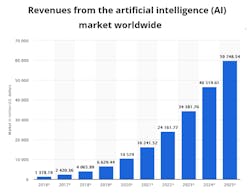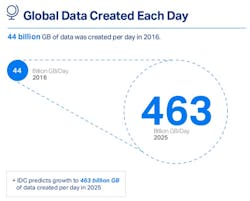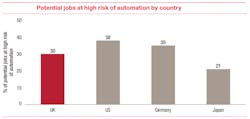How Machine Intelligence will Revolutionize the Machines of the Future
Despite the overwhelming impact of automation resulting from machine learning and artificial intelligence, it is already being used in several valuable ways. The global AI market is expected to reach nearly $59 billion by 2025. Recently, however, the hype around the term “machine learning” has caught the attention of industry experts and tech enthusiasts.
The development of machine intelligence will change every aspect of our lives in future. That’s why it is imperative to know how MI will affect machines in future. But before we dig any deeper, let's first understand what machine intelligence is.
What Is Machine Intelligence, and How is it Different from Artificial Intelligence?
Machine intelligence is the branch of technology where machine learning and artificial intelligence overlap. Simply put, it uses AI to make machines smarter using various machine learning algorithms. There is no consensus on how to define machine intelligence and how to distinguish it from AI. All we can say for now is that this technology enables a machine to interact with its environment just like a human being would. However, AI can appear as a component of the machine intelligence in complex machines, usually as a computer application or digital interface.
Driving Factors Behind the Rise of MI
Machine intelligence is making huge strides at a record pace because the demand for efficient, highly productive, and intelligent machines is also on the rise. From manufacturing to customer service, every industry needs machines that can process the vast amount of data accurately and make decisions accordingly.
Data. The growing volumes and varieties of data are the primary driving forces behind widespread acceptance and demand for machine intelligence. Over the past few years, the internet has also witnessed an unprecedented amount of data creation and uploads from average users. The rise of social media further fueled this creation, resulting in an era of data overload. Around 44 billion GB data was created per day in 2016.
Deep learning. The development of algorithms for deep learning and the increased use of deep neural networks (Deep Nets) are also fostering the growth of MI. With the ever-evolving deep learning software programs, analyzing vast amounts of data to recognize desired patterns has become much easier.
Hardware. Hardware is the skeleton of the modern neural network. Today, we have enough data and sufficient computing power (hardware) to carry out complex deep learning processes. Whether it is Nvidia’s deep learning chip or Qualcomm’s new neural processing unit (NPU), the development in hardware sector will continue to enhance MI applications.
How MI has Changed the Way Machines Operate Today
Though smart machines haven't taken over our lives yet, they are certainly taking over crucial functions across industries. In fact, there are several machine intelligence applications in use today.
Optimize and automate processes. Thanks to the enhanced automation, most businesses can leave mundane and routine tasks to intelligent machines. MI has ushered in a new era of mechanization where robots can make decisions in real-time without human interference.
Detect, analyze, and predict trends and patterns. Smart robots and computers can recognize, process, and predict various trends and patterns. The e-commerce and retail industries are particularly interested in developing applications to recognize and predict customer behavior and online shopping patterns. Amazon's transactional AI platform is one of the many such applications being used today.
Future Predictions for Machine Intelligence
In future, MI will enable robots and machines to perform a complicated surgery or drive a truck full of hazardous material across the continent without an accident. While most of this technology may seem like a story right out of a science fiction film, one day sophisticated MI will change our lives forever.
Reshaping economies. Machine intelligence will have a substantial impact on the global economy as a whole. It will lead to increase automation, which in turn, will have an immense impact on the global economy as smart machines will take over most jobs. Job losses due to advances in technology aren't new; however, AI is likely to turn most national economies upside down. The increased automation could eliminate 38% jobs in the U.S., 35% in Germany, 30% in the UK, and 21% in Japan.
However, by the 2030s, 5% or more of jobs may be generated in areas related to new robotics or AI. They will be of a kind that doesn’t even exist now. It is difficult to know what these new types of jobs will be in advance, but there will be a few job gains from this development.
Taking over hazardous jobs. Smart machines and robots will also take over dangerous jobs such as defusing bombs or handling radioactive material. Working in perilous conditions such as scorching heat, earsplitting noise, and toxic environments can also be outsourced to intelligent robots. Thus, MI will be able to save thousands of lives in future.
Robots as coworkers. Cobots, as they are called, will be able to physically interact with humans in a shared workspace. Factories around the globe such as SEW-Eurodrive’s factory in Baden-Württemberg have already started using cobots on shop floors. At SEW-Eurodrive, human workers work alongside robotic trucks that keep restocking the workstations on the floor. As robots become smarter, the risk of working with them will reduce further. As a result, this trend will only get stronger in future.
Wrapping Up
Machine Intelligence is no longer a science fiction fantasy. It is very much real, and more practical applications of these technologies will flourish in the coming years. Hopefully, this article will help you understand what machine intelligence is and how it’s transforming machines both today and tomorrow.
About the Author
Jack Warner
Marketing Executive
Jack Warner is a tech enthusiast who is passionate about latest technologies, especially machines and IoT. He loves staying updated with everything that's happening in the IoT world and a great admirer of Elon Musk. He currently works for Power Jack Motion.




